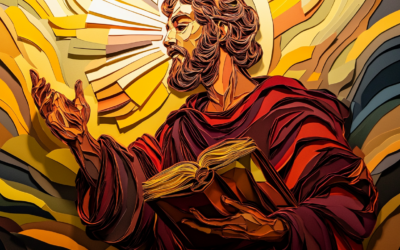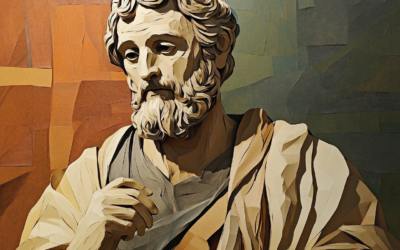The Man Behind the Name
Peter wasn’t always called Peter. He started as Simon, a fisherman from Bethsaida (John 1:44). Jesus gave him the name Cephas (Aramaic for “rock”), translated as Petros in Greek (John 1:42). He was part of Jesus’ inner circle—one of the three closest disciples alongside James and John (Mark 5:37, Matthew 17:1).
But before he became the “Rock,” Peter was impulsive, hot-headed, and full of contradictions. He had the faith to walk on water—but only for a few steps before fear took over (Matthew 14:29-30). He was the first to declare Jesus as the Messiah (Matthew 16:16) and the first to cut off a soldier’s ear when things got tense (John 18:10). He pledged unwavering loyalty—then denied Jesus three times when the heat was on (Luke 22:61-62).
Peter wasn’t polished, but he was passionate. And that’s who Jesus picked to lead the church.
Peter the Fisherman: A Simple Beginning
Peter and his brother Andrew were fishermen on the Sea of Galilee (Matthew 4:18). Fishing was hard, physical labor—long nights, rough waters, and the constant smell of fish. When Jesus called, he dropped everything and followed (Luke 5:1-11).
The Call to Follow
And He said to them, “Follow Me, and I will make you fishers of people.” Immediately they left their nets and followed Him.
Matthew 4:19-20 (NASB)
Peter didn’t hesitate. He walked away from the only life he’d known to follow a rabbi who had no money, no army, and no political power. This was either reckless or a sign of radical trust.
The Highs and Lows of Peter’s Faith
Peter’s spiritual journey looked like a roller coaster. One moment, he was making bold declarations. The next, he was putting his foot in his mouth.
Peter’s Greatest Moment: Recognizing the Messiah
Simon Peter answered, “You are the Christ, the Son of the living God.” And Jesus said to him, “Blessed are you, Simon Barjona, because flesh and blood did not reveal this to you, but My Father who is in heaven.”
Matthew 16:16-17 (NASB)
This was a big deal. No one else had said it so clearly. Jesus affirmed Peter’s insight as divinely inspired.
Then, just a few verses later, Peter got a sharp rebuke:
But He turned and said to Peter, “Get behind Me, Satan! You are a stumbling block to Me; for you are not setting your mind on God’s purposes, but on man’s.”
Matthew 16:23 (NASB)
Ouch. From “blessed” to “Satan” in less than a chapter. That was Peter—capable of profound insight and complete misunderstanding within minutes.
Peter Walks on Water (Briefly)
And Peter responded and said to Him, “Lord, if it is You, command me to come to You on the water.” And He said, “Come!” And Peter got out of the boat and walked on the water, and came toward Jesus. But when he saw the strong wind, he became frightened, and he began to sink.
Matthew 14:28-30 (NASB)
Faith made him step out. Fear made him sink. Jesus still caught him.
The Denial: Peter’s Lowest Moment
‘Even if they all fall away because of You, I will never fall away!’
Matthew 26:33 (NASB)
Hours later, he denied Jesus three times (Luke 22:61-62). That moment broke him. The man who had been so sure of his strength was left weeping.
The Restoration: Peter’s New Beginning
He said to him the third time, “Simon, son of John, do you love Me?” Peter was hurt because He said to him the third time, “Do you love Me?” And he said to Him, “Lord, You know all things; You know that I love You.” Jesus said to him, “Tend My sheep.”
John 21:17 (NASB)
Jesus was putting Peter back on his feet. His failure wasn’t final, and his denial didn’t define him.
Peter at Pentecost: The Bold Preacher
Peter’s Later Years and Martyrdom
After Pentecost, Peter didn’t settle down. He traveled extensively, spreading the gospel far beyond Jerusalem. His journeys likely took him through Antioch, Asia Minor (modern-day Turkey), and ultimately to Rome. Along the way, he wrote two letters—1 and 2 Peter—addressed to believers facing persecution, encouraging them to endure suffering with faith and hope. His letters reflect a man refined by trials, urging the church to stand firm in Christ.
Peter’s final years were marked by suffering. According to early church tradition, he was in Rome during Emperor Nero’s persecution of Christians (AD 64). The Roman historian Tacitus describes how Nero falsely blamed Christians for the Great Fire of Rome, leading to brutal executions. Though Scripture does not record Peter’s death, historical sources strongly suggest he was martyred around AD 64-67.
The 4th-century historian Eusebius (Ecclesiastical History 3.1.2) states that Peter was crucified upside down at his own request, believing himself unworthy to die in the same manner as Jesus. Earlier, Clement of Rome (c. AD 96) referenced Peter’s suffering and death (1 Clement 5:4-6), further supporting the tradition of his martyrdom.
Though Peter died, his influence lived on. His preaching, letters, and leadership in the early church laid a foundation for Christianity that remains unshaken.
Peter’s Legacy
- The First to Proclaim Jesus as the Christ (Matthew 16:16)
- Leader of the Early Church (Acts 2:14)
- Author of Two New Testament Letters (1 and 2 Peter)
- Martyr for the Faith (Tradition: crucified under Nero)
Scholarly References & Sources
- Eusebius, Ecclesiastical History (Book 3, Chapter 1) – Early record of Peter’s martyrdom.
- Clement of Rome, 1 Clement (Chapter 5) – Another early reference to Peter’s death.
- F.F. Bruce, The New Testament Documents: Are They Reliable?
- Craig Keener, The IVP Bible Background Commentary
- N.T. Wright, The New Testament and the People of God
- Raymond E. Brown, Introduction to the New Testament
Scripture quotations taken from the (NASB®) New American Standard Bible®, Copyright ©, 2020 by The Lockman Foundation. Used by permission. All rights reserved. lockman.org









0 Comments